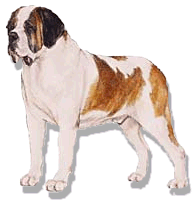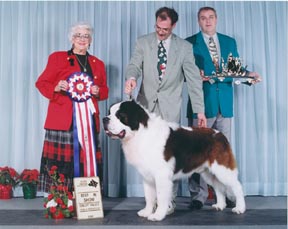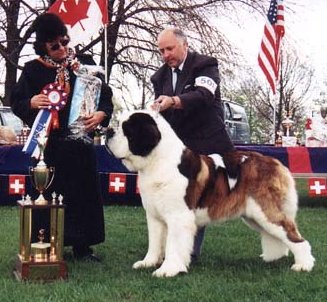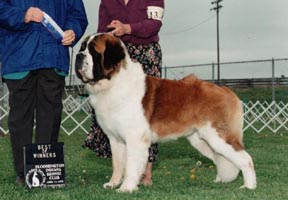
![]() The Saint Bernard
is a hard worker known for his loyalty and dedication. In A.D. 1050, Archdeacon
Bernard de Menthon founded the famous Hospice in the Swiss Alps as a refuge
for travelers crossing the treacherous passes between Switzerland and
Italy - and the Saint Bernard was already an established breed. These
dogs - referred to as Talhund (Valley Dog) or Bauernhund (Farm Dog) -
were widely used in the valley farms and Alpine dairies for a variety
of guarding, herding, and drafting duties.
The Saint Bernard
is a hard worker known for his loyalty and dedication. In A.D. 1050, Archdeacon
Bernard de Menthon founded the famous Hospice in the Swiss Alps as a refuge
for travelers crossing the treacherous passes between Switzerland and
Italy - and the Saint Bernard was already an established breed. These
dogs - referred to as Talhund (Valley Dog) or Bauernhund (Farm Dog) -
were widely used in the valley farms and Alpine dairies for a variety
of guarding, herding, and drafting duties.

![]() The Saint Bernard
is a powerful, proportionately tall figure, strong and muscular in every
part, with a powerful head and intelligent expression. His massive head,
like the whole body, is very powerful and imposing - dogs with a dark
mask appear more stern, but never ill-natured. The skin of the forehead,
above the eyes, forms rather noticeable wrinkles.
The Saint Bernard
is a powerful, proportionately tall figure, strong and muscular in every
part, with a powerful head and intelligent expression. His massive head,
like the whole body, is very powerful and imposing - dogs with a dark
mask appear more stern, but never ill-natured. The skin of the forehead,
above the eyes, forms rather noticeable wrinkles.

![]() The
Saint Bernard's muzzle is short, and the slope from the skull to the muzzle
is sudden and rather steep. The "flews" of the upper jaw are strongly
developed, turning in a beautiful curve into the lower edge, and slightly
overhanging. His eyes are set more to the front than the sides, are of
medium size, dark brown, with intelligent, friendly expression, set moderately
deep. The lower eyelids, as a rule, do not close completely.
The
Saint Bernard's muzzle is short, and the slope from the skull to the muzzle
is sudden and rather steep. The "flews" of the upper jaw are strongly
developed, turning in a beautiful curve into the lower edge, and slightly
overhanging. His eyes are set more to the front than the sides, are of
medium size, dark brown, with intelligent, friendly expression, set moderately
deep. The lower eyelids, as a rule, do not close completely.
![]() The
Saint Bernard's coat is very dense, tough, short-haired and lying smooth,
without feeling rough to the touch. Coat color is white with red or red
with white, the red in its various shades; brindle patches with white
markings. Necessary markings are: white chest, feet and tip of tail, noseband,
collar or spot on the nape; the latter and blaze are very desirable.
The
Saint Bernard's coat is very dense, tough, short-haired and lying smooth,
without feeling rough to the touch. Coat color is white with red or red
with white, the red in its various shades; brindle patches with white
markings. Necessary markings are: white chest, feet and tip of tail, noseband,
collar or spot on the nape; the latter and blaze are very desirable.

![]() The
longhaired type Saint Bernard completely resembles the shorthaired type,
except for the coat which is not shorthaired but of medium length plain
to slightly wavy. The tail is bushy with dense hair of moderate length.
Rolled or curly hair, or a flag tail, is faulty. Face and ears are covered
with short and soft hair; longer hair at the base of the ear is permissible.
The
longhaired type Saint Bernard completely resembles the shorthaired type,
except for the coat which is not shorthaired but of medium length plain
to slightly wavy. The tail is bushy with dense hair of moderate length.
Rolled or curly hair, or a flag tail, is faulty. Face and ears are covered
with short and soft hair; longer hair at the base of the ear is permissible.

![]() The
Saint Bernard loves children. All Saint Bernards need lots of room and
exercise. If you have the space and have the time to exercise your dog
Saint Bernards make good house dogs and companions. If you would like
to know more about this powerful, family-friendly dog, contact the Saint
Bernard Club of America.
The
Saint Bernard loves children. All Saint Bernards need lots of room and
exercise. If you have the space and have the time to exercise your dog
Saint Bernards make good house dogs and companions. If you would like
to know more about this powerful, family-friendly dog, contact the Saint
Bernard Club of America.

|
AKA Shari Lyne. All rights reserved. Most artwork originally created by Shari Lyne/StoryTeller; if you own the copyright to any original image used for the creation of the graphics on this site please e-mail with proof of copyright. Upon receipt of said copyright, credit or removal of your image will be done. |